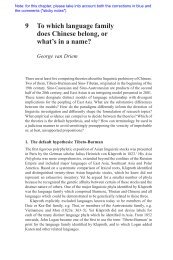1 Austronesian cultural origins
1 Austronesian cultural origins
1 Austronesian cultural origins
You also want an ePaper? Increase the reach of your titles
YUMPU automatically turns print PDFs into web optimized ePapers that Google loves.
34 Peter Bellwood and Eusebio Dizon<br />
(3) the large quantities of Taiwan slate and Fengtian nephrite from Anaro, plus<br />
some Anaro stone adzes that appear also to be imports from Taiwan, all dating<br />
from 1000 bc onwards;<br />
(4) possibly the bones of domesticated pigs from at least 3000 bp in Sunget<br />
(Torongan and Reranum have no preserved animal bone). The Batanes have<br />
no evidence for a pre‑human wild pig population, and the wild pig of Luzon,<br />
Sus philippensis, was apparently never domesticated (Groves 1997).<br />
Evidence for contemporary contact with northern Luzon, which was<br />
presumably reached by Neolithic settlers from Taiwan at about the same time<br />
as the Batanes Islands, includes many of the Anaro stone adzes with trapezoidal<br />
cross‑sections (some tanged), mostly of pale grey metamorphic rock. These are<br />
paralleled closely in some Cagayan Valley sites with red‑slipped pottery, such<br />
as Irigayen. Also of non‑Taiwan origin may be the habit of decorating pottery<br />
with zones of stamped circles (from Sunget and Anaro onwards, but apparently<br />
not yet innovated in the basal layer at Torongan). Indeed, one wonders if this<br />
Batanes circle stamping formed the background to the development of both circle<br />
and dentate stamping in the Neolithic of the Cagayan Valley, and ultimately to<br />
the early Marianas and Lapita dentate‑ and circle‑stamping traditions. At present,<br />
the chronology is not tight enough to resolve this issue, and it is, of course,<br />
quite possible that innovations flowed back as frontiers extended, as in the case<br />
of the Talasea obsidian from New Britain found in the early red‑slipped pottery<br />
assemblage at Bukit Tengkorak in Sabah (Bellwood and Koon 1989). However,<br />
derivation of the whole Neolithic complex present in the Batanes and Cagayan<br />
from the south is to our minds completely impossible. We now have enough C 14<br />
dates from the Batanes and Cagayan, detailed in Table 1.1, to give this region an<br />
edge of at least 500 years over the beginning of the Lapita sequence in western<br />
Melanesia.<br />
The movement of population from eastern Taiwan into the northern Philippines,<br />
probably between 2500 and 2000 bc on present evidence (Hung 2005), formed<br />
the first stage in an astounding spread of a Neolithic population that reached<br />
western Polynesia by only a millennium or so later, traversing a maritime distance<br />
of almost 10,000 km (Bellwood 1997, 2004a, 2004b, 2005). Until now, it has<br />
been possible to argue in vacuo that many <strong>Austronesian</strong>‑speaking populations,<br />
such as Polynesians, could not have originated in Taiwan because there is no<br />
relevant archaeological record in support (Oppenheimer 2004; Oppenheimer and<br />
Richards 2001). Such arguments can only be made if one ignores the linguistic<br />
and archaeological records altogether, or makes the historically unsupportable<br />
assumption that the <strong>Austronesian</strong> languages spread as ‘trade languages’, without<br />
native speaker transmission (see Malcolm Ross’s chapter in this volume for a firm<br />
statement against this possibility). Clearly, it is true that not all <strong>Austronesian</strong>‑<br />
speaking populations originated genetically in Taiwan – no one would make this<br />
claim, for instance, for many eastern Indonesian or Melanesian populations, or<br />
even for the Agta of northern Luzon. But to extend this argument to the languages<br />
and material cultures of <strong>Austronesian</strong> prehistory and to deny Taiwan’s role in



